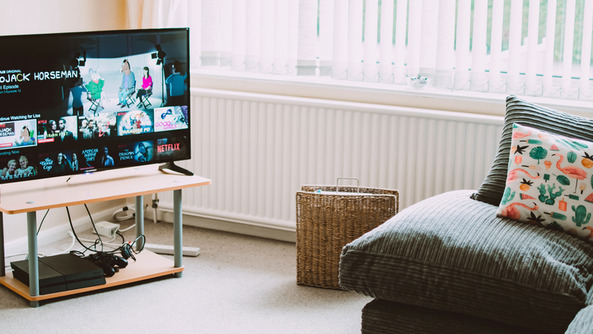Building and installing your own home theater can be quite a riveting and rewarding experience. But that’s only the case if you know what you’re doing. Getting into it unprepared would make it nothing short of a nightmare due to the time and effort you’d have to put in.
And while improvisation is a great tool that may work for several projects, setting up a home theater system isn’t one of them due to all its different components.
So fortunately for you, we’ve come up with a comprehensive plan that will take you through the process of setting up your home theater step by step.
Let’s get right into it!
The Core Components of Home Theater System
First things first, before you start setting up a home theater system, make sure to purchase all the necessary components.
So here’s a list you can follow to avoid an extra trip to the market:
1. Video streaming source
2. Audio system
3. A/V home theater receiver for the audio system
4. Display device
5. Connection cables
6. Projector.
Common Types of Home Theater Systems
There are a few different types of theater systems and the main difference between them is the way in which they are set up. That’s why the next thing to cover is to help you decide which one’s best for you.
So let’s take a look at each and figure out how they differ from one another to help you make an informed decision.
1. Component System
In this system, the audio and video components are set up separately and linked together wirelessly or through wires (depending on the compatibility).
Some standard components you’ll require include, a standalone A/V receiver, subwoofer and speakers and a source component like a DVD player. As you have to install everything separately, setting this system up can be a bit challenging. But due to its easy customizability, it’s also quite beneficial.
That’s because if you want to make minor changes to it, you can just replace a single component without disturbing the rest of the system.
2. Home Theater In-a-Box System
This system contains most of the same gadgets as the previous one including a surround sound system, a Blu-ray or disc player and an A/V receiver. Yet, there is one major difference between the two.
To begin with, as the name suggests, this system is sold in a single box which includes all the different parts, hence why it’s called in-a-box. Plus, it has a further two subtypes, the 5.1 or the 7.1. The 5.1 contains 5 surround speakers and the 7.1 contains, you guessed it, 7 surround speakers and one subwoofer.
Although the Home Theater In-a-Box System isn’t as customizable as the previous, it does benefit from its matching components that work perfectly in sync with each other. Lastly, if you want to purchase it then you can simply order it online.
6 Steps to Set Up a Home Theater System
Now that you know the basics, it's time to get down to brass tacks and lay out our step by step guide to building a home theater system.
Step 1: Find the Right Place
Deciding on the perfect place can sometimes be quite an ordeal. So first and foremost, you must choose where you want to place your home theater system.
Start by deciding whether the system is for your individual use or for family gatherings. For individual use, you don’t need much space and even a small room would work.
However, if you intend to invite your friends and family to watch then you’d need to dedicate a bigger space to the system. That’s why this step has a lot to do with the size of your house and the options that you have in terms of space.
This is also the reason that some people even decide to build a separate room for their home theater because they don’t want to be tied down by the original room’s restrictions.
Step 2: Mount the Screen and Projector
After you’ve decided on the room, the next step is to begin the installation. And the first thing you need to install is your display device or screen and home theater projector.
Setting up your projector can be the trickiest part of this whole setup because, for ideal use, you need to install it on your ceiling and get the perfect angle so that the images are perfectly aligned on the screen.
Some projectors come with the lens shift and keystone adjustment that helps you align the image and set it in a specific position. So check if your projector offers any of that. Otherwise, it would take some trial and error but keep trying until you don’t get the ideal screen alignment.
Step 3: Connect the Sound
The sound system can make or break your experience, so this is one department where you don’t want to cut corners while setting up your home theater speakers.
There are a variety of options to choose from. However, most prefer stereo sound that consists of a total of two speakers, positioned on the left and right of the screen to give the viewer a sense of directionality. Plus, it’s also one of the more affordable choices.
Although if your home theater room is big enough, we would recommend installing a surround sound or multi channel home theatre. The speakers placed at the front and back of the listener can almost perfectly replicate the atmosphere of a theater.
Step 4: Set Up a Streaming Source
Now that your screen, projector and sound system is all hooked up and ready to go, you need to set up a streaming source to help you play your favourite movies and TV shows of your choice.
The simplest way is to connect an HDMI cable from your display device to your laptop. Although if that doesn’t work for you, you can also get a DVD player or a Blu-ray player and hook it up to your screen.
Otherwise, modern projectors can also be wirelessly connected to your phone via Chromecast. If that works for you, then you can simply enjoy a variety of shows on streaming services like Netflix.
Step 5: Home theater Seating
Cast your mind back to when we talked about how important it was for you to know the number of people you’re going to seat. Well, that is going to play a major role when you’re preparing your home theater seating arrangement.
For individual use or small gatherings, two or three comfortable recliners, positioned in front of the screen should do the trick.
But if you intend to invite a large number of people to watch with you then the seats will have to be more strategically placed according to the space in the room and in front of the screen.
Step 6: Home theater Curtains
Your setup is simply incomplete without theater drapes. Not only can they add a real theater feel to your home but also minimize the light reflected on your screen.
In addition to all that, the main function of soundproof curtains is to reduce outside noise and echo, which goes a long way in improving the overall acoustics.
And if you’re unable to decide the kind of drapes to go for then we’ve covered that in detail in our home theater curtains guide, so be sure to check that out.
Bonus Step: Finish It with a Concession Stand
Continuing on our crusade to help you achieve the authentic theater experience, we’d suggest putting up a small but adequate home theater concession stand in your room.
Whether you have guests or not, having a concession stand will allow you to always have snacks on deck. Plus, the added feeling of going to get snacks from the stand will give your home theater a more cinematic experience.
If this is out of your budget, then don’t worry because we’ve also written an article on how you can build a DIY home theater concession stand.
Do I need a Home Theater Power Manager?
The power manager’s basic job is to protect your home theater system and all the associated gadgets from problems like power surges and power flow.
Whether or not you need a home theater power manager depends solely on your location. If you live in an area where power surges are common, then it’s absolutely necessary for you to invest in a power conditioner.
You can learn more about whether a home theatre power manager is important for you by going through our in-depth guide.
Is a Home Theater System Really Worth It: In Closing
If you find yourself going to the theater from time to time, then a home theater system is totally worth it for you.
It’s a one-time investment that allows you to enjoy your favourite shows and movies from the comfort of your home.
Besides, setting it up isn’t too difficult either, especially if you’re going for a Home Theater In-a-Box System as it will provide you with all the components that you need in one place.
In addition, the convenience it offers is beyond belief because you can get that authentic cinema experience anytime you want with just the push of a button on your remote.









